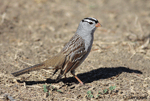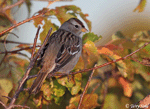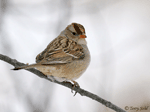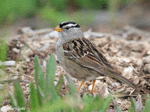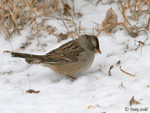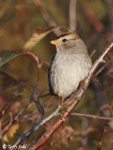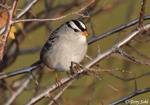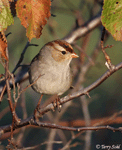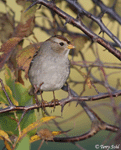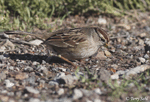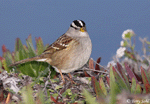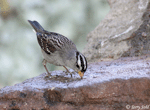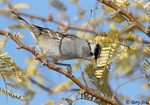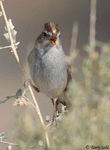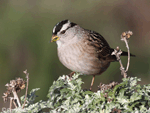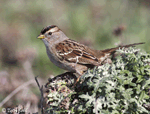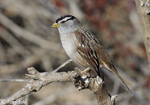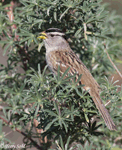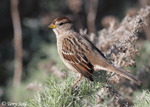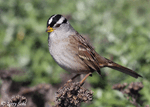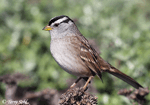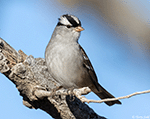| Length: 6.5 to 7.5 inches | Wingspan: 9 to 10 inches | Seasonality: Migrant |
| ID Keys: White crown with black stripes, black eyestripe, 2 white wing bars | ||
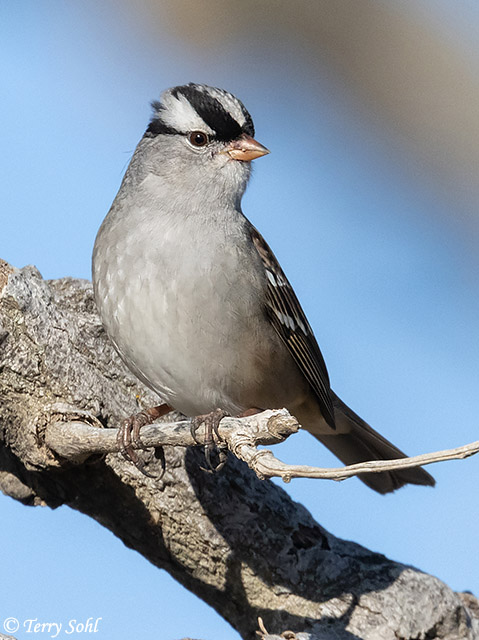 White-crowned Sparrows are
a fairly common migrant
through the state (and occasional winter resident in the far southern part of
the state). They are well known for the amazing
range of dialects from one location to another, and are one of the most studied
of bird species in North America. Young males learn their songs in their
first few months of life, "picking up" a song style in the local environment
where they're raised. As individual birds often return to the same
general area for breeding, local populations have thus developed their own
dialects. A fully-mature White-crowned Sparrow is shown in the photo to
the right. Immature (first-year) birds typically have less bold
markings on the head (see photos at the bottom of the page).
White-crowned Sparrows are
a fairly common migrant
through the state (and occasional winter resident in the far southern part of
the state). They are well known for the amazing
range of dialects from one location to another, and are one of the most studied
of bird species in North America. Young males learn their songs in their
first few months of life, "picking up" a song style in the local environment
where they're raised. As individual birds often return to the same
general area for breeding, local populations have thus developed their own
dialects. A fully-mature White-crowned Sparrow is shown in the photo to
the right. Immature (first-year) birds typically have less bold
markings on the head (see photos at the bottom of the page).
Habitat:
On their migration through the state White-crowned Sparrows can be found in a very wide variety of habitats, including forest edges, brush, thickets, parks, residential areas, and agricultural areas. On their summer breeding grounds they are found in open and semi-open habitats, including grassy meadows, open tundra, woodland edges and clearings, and open shrublands.
Diet:
The diet for most of the season primarily consists of seeds, but during the summer breeding season many insects and small invertebrates are consumed. They may also sometimes feed on waste grain, fruits, and berries. They will frequently visit feeder areas, although they typically scratch for food on the ground below the feeder rather than visiting the feeder itself.
Behavior:
White-crowned Sparrows primarily forage on the ground, or occasionally low in vegetation, where they can be seen hopping along and scratching on the ground in search of fallen seeds or other food items. They will also occasionally fly out from a perch to catch flying insects. They are often gregarious outside of the mating season, foraging in loose flocks, often mixed with other sparrow species.
Nesting:
Non-breeder in South Dakota. On their breeding grounds White-crowned Sparrows nest on the ground or very close to it, with the being placed in a low shrub (typically within 5 feet of the ground), within a thick tussock of grass just off the ground, or on the ground itself. The nest is built by the female and is a cup built of grasses, moss, bits of bark, twigs, and other vegetative material, lined with hair and grasses. The female lays between 2 and 6 eggs that are a light bluish to light greenish in color, speckled with a rusty brown. The female alone incubates the eggs, with incubation lasting about 12 or 13 days. The young fledge from the nest 10 to 12 days after hatching.
Song / Call:
Skilled vocalists, White-crowned Sparrows have a wide variety of songs, with songs varying widely between different locations. Mnemonics to help remember the White-crowned Sparrow song include "more more more cheeeeeeezies", with a buzzy or trilled ending. In reality...that doesn't sound like a White-crowned Sparrow to me! The song of a White-crowned Sparrow typically starts with some whistled notes, before transitioning to some buzzy notes, or sometimes, a trilled ending to the song. They also have a variety of calls, including a crisp repeated peek, or a breathy wheet that's often given respectively as an alarm call.
- Click here to hear a repeated peek call of a White-crowned Sparrow1
- Click here to hear the song of a White-crowned Sparrow2
- Click here to hear another song version of a White-crowned Sparrow3
- Click here to hear a breathy wheet alarm call of a White-crowned Sparrow4
- Click here to hear yet one more song version of a White-crowned Sparrow5
Migration:
Most summer in northern Canada, Alaska, and the Rocky Mountains. Most winter in the southern half of the U.S., the west coast, and Mexico. However, there is a non-migratory population along the coastline of California. In South Dakota they are mostly present as migrants, in both the spring and the fall. However, a few may sometimes try to over-winter in the southern part of the state (primarily first-year birds from my experience).
Interactive eBird map:
Click here to access an interactive eBird map of White-crowned Sparrow sightings
Similar Species:
White-throated Sparrows could potentially be confused with the following species:
- White-throated Sparrow - White-throated Sparrows are another migrant in South Dakota that can also sometimes be seen in mixed flocks with the White-crowned Sparrow. The black and white striping pattern on the top half of the head can be confusing, as adult White-throated and White-crowned Sparrows both have a similar pattern of black behind the eye, a white "eyebrow", and a black crown with a white stripe down the middle. However, as the namesake implies, White-throated Sparrows also have a white patch on their throat, a feature that is there on both adult and juvenile birds. White-throated Sparrows also have a yellow spot in front of the eye that's lacking on a White-crowned Sparrow. Immature birds of both species can be differentiated by the color of the crown stripes, as young White-throated sparrows still have a black crown with a lighter (tannish) stripe in the middle, while young White-crowned Sparrows have a reddish-brown crown. In all ages, bill color can be used to differentiate the two species as White-throated Sparrows have a dull grayish bill, while White-crowned Sparrows have a orange bill.
- Golden-crowned Sparrow - Golden-crowned Sparrows are normally birds of the western edge of North America, although there have been a handful of records in South Dakota. In terms of appearance, they look very similar except for the top half of the head. There, the Golden-crowned Sparrow has black top of the head, with golden patch at the top of the head, compared to the alternating black and white pattern on the head of a White-crowned Sparrow. The bill of a Golden-crowned Sparrow is also a duller gray compared to the orange bill of a White-crowned Sparrow.
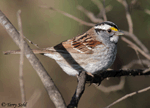 |
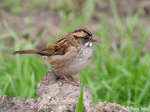 |
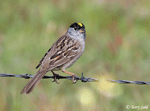 |
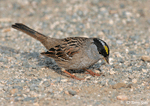 |
| White-throated Sparrow (adult) | White-throated Sparrow (immature) | Golden-crowned Sparrow | Golden-crowned Sparrow |
Bird Feeders:
White-crowned Sparrows will attend feeders for most seeds, particularly sunflower seeds. They are most likely to be found scratching on the ground underneath a feeder than up on the feeder itself, although they will partake of a broad platform feeder.
Conservation Status:
There are several different populations of this species, most of which seem to be stable. However, there are indications that some populations in the western United States are declining. Overall though, systematic surveys such as the Christmas Bird Count and Breeding Bird Survey show stable populations of the population as a whole. They are still common in many parts of their range and are found over a very broad geographic area. The IUCN thus considers the White-crowned Sparrow to be a species of "least concern".
Further Information:
- WhatBird - White-crowned Sparrow
- BirdWeb - White-crowned Sparrow
- Audubon Guide - White-crowned Sparrow
Photo Information:
October 12th, 2012 -- Minnehaha County, South Dakota -- Terry Sohl
Additional Photos:
Click on the image chips or text links below for additional, higher-resolution White-crowned Sparrow photos.
Audio File Credits:
- 1Simon Elliott. Recorded on Vancouver Island in British Columbia, Canada on July 9th, 2003. Original recording and information available from xeno-canto.
- 2Steve Hampton. Recorded in Mason County, Washington on July 3rd, 2016. Original recording and information available from xeno-canto.
- 3Jim Holmes. Recorded in Elko County, Nevada on June 28th, 2016. Original recording and information available from xeno-canto.
- 4Richard E. Webster. Recorded in Cedar Breaks National Monument in Utah on June 18th, 2018. Original recording and information available from xeno-canto.
- 5Richard Hoyer. Recorded in Deschutes County, Oregon on June 21st, 2018. Original recording and information available from xeno-canto.
| Click on the map below for a higher-resolution view |
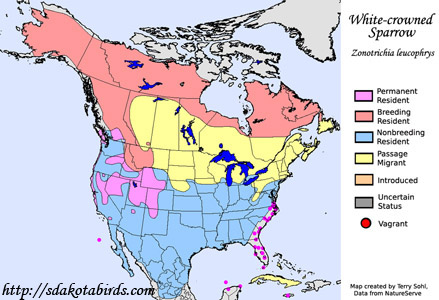 |
| South Dakota Status: Common migrant throughout the state. Casual winter visitor, primarily in the southern part of the state. |
Additional White-crowned Sparrow Photos
Click for a higher-resolution version of these photos
